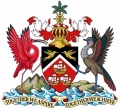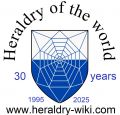National Arms of Trinidad and Tobago
|
|
| English |
Arms: Per chevron enhanced Sable and Gules, a chevronel enhanced Argent, between in chief two humming birds (Polytmus guainumbi – Trochilidae) respectant Or, and in base the three ships of the fleet of Christopher Colombus, the Santa Maria, the Pinta and the Nina also Or, the sails set, proper. |
Origin/meaning
The arms were officially adopted on February 25, 2025 and replaced the previous arms, adopted on August 9, 1962.
The three ships in the old arms are the fleet of Columbus. Above the ships are two hummingbirds. The red ibis (Eudocimus ruber) is the national bird of Trinidad, standing on a three-topped hill, from which the island got its name (mountain of trinity). The Cocrico (Ortalis ruficauda) bird on the left side is the national bird of Tobago.
In 2024 it was decided to remove the ships of Columbus and replace them with a more local symbol. For this the steeldrum was selected, a typical instrument for the islands.
Image gallery
Colonial arms
The Crown Colony of Trinidad and Tobago was formed in 1889, under a constitution that left Tobago with its own legal and fiscal systems. Full administrative amalgamation came in 1899.
The colony used a landscape badge,/arms both on its seal and on the flags used by the colony - the Union Jack used by the Governor, the Blue Ensign used by Government vessels and the Red Ensign used by merchant vessels.
The badge shows an island peak with the sea in the foreground, and square-rigged sailing ships entering a harbour at right. The masoned stone groyne has a flagpole bearing the Union Jack as a prominent part of the design.
The colony obtained independence in 1962, but the badge continued to be in use until 1967.
Tobago (Nieuw Walcheren)
In 1651 Jacob (James) Kettler (1610-1682), Duke of Courland (Latvia), obtained a grant of the island from King Charles I and established a settlement in the north of Tobago. During the Swedish-Polish war (1655-1660) Duke Jacob was captured and the colony was lost to the Dutch. The Peace of Oliva (near Danzig), ended this war and Tobago was regained for just a short period at the end of Jacob’s rule. On Jacob’s death in 1682, his son, Friedrich Casimir, the next Duke was not interested in the island’s now dwindling export potential. He subsequently sold Tobago to British colonists.
At the same time Nieuw Walcheren (New Walcheren) was a small Dutch colony on the Southern coast of Tobago. In total 4 attempts of settlement were made, but only in 1654 the colony survived. It was named Nieuw-Walcheren, after the island of Walcheren in Zeeland province. The colony was founded by the Lampsins brothers from Vlissingen (on Walcheren) and the settlement was named Nieuw Vlissingen (later Lampsinsburg, now the capital of Tobago, Scarborough). Even though the Dutch received Tobago by the Peace of Westminster, the French King also laid claim on Tobago. This was partly resolved by making the Lampsins Barons of Tobago by the French King. This title they used until 1848, even though the colony was conquered by the English in 1666.
The Lampsin family used a swimming whale as arms for Tobago in their family arms. This was derived from the arms of the island of Walcheren. Below the arms of Cornelis Lampsins, Baron of Tobago with in the 3rd quarter the Tobago arms and in the 4th the arms of the island of Sint Maarten (which they also owned) as shown in the Grote Kerk in Vlissingen (Netherlands).
After being occupied for short periods by the Dutch and the French, Tobago was ceded by France to Britain in 1763 under the Treaty of Paris. It was captured by the French in 1781 and then recaptured by the British in 1793. The island was finally ceded to Britain in 1814 by the Treaty of Paris, becoming a Crown Colony in 1877 and in 1888 being amalgamated politically with Trinidad.
In 1816 the motto PULCHRIOR EVENIT (It arises more beautiful than ever) was given to the colony. This motto goes back to a jeton of king Louis XIV showing his arms on the obverse and a sun rising from a cloud on the reverse. Almost exactly the same picture of the reverse of this jeton was on a button of the British Admiralty on Tobago made between 1838-42. It is supposed that this was the first badge of the colony. A second badge was adopted in 1880 showing a rising sun above the Island with a palmtree on the foreground and a sailing vessel on the roads. In base is the Louis XIV motto
Literature: Tobago part : http://nl.wikipedia.org/wiki/Nieuw_Walcheren, image from http://www.sintjacobskerk.nl/rouwborden.htm
Trinidad and Tobago heraldry portal
This page is part of the Trinidad and Tobago heraldry portal |
Heraldry of the World |
|
Civic heraldry:
|
Other heraldry: |
Contact and Support
Partners:
Your logo here ?
Contact us
© 1995-2025, Heraldry of the World, Ralf Hartemink 
Index of the site




















